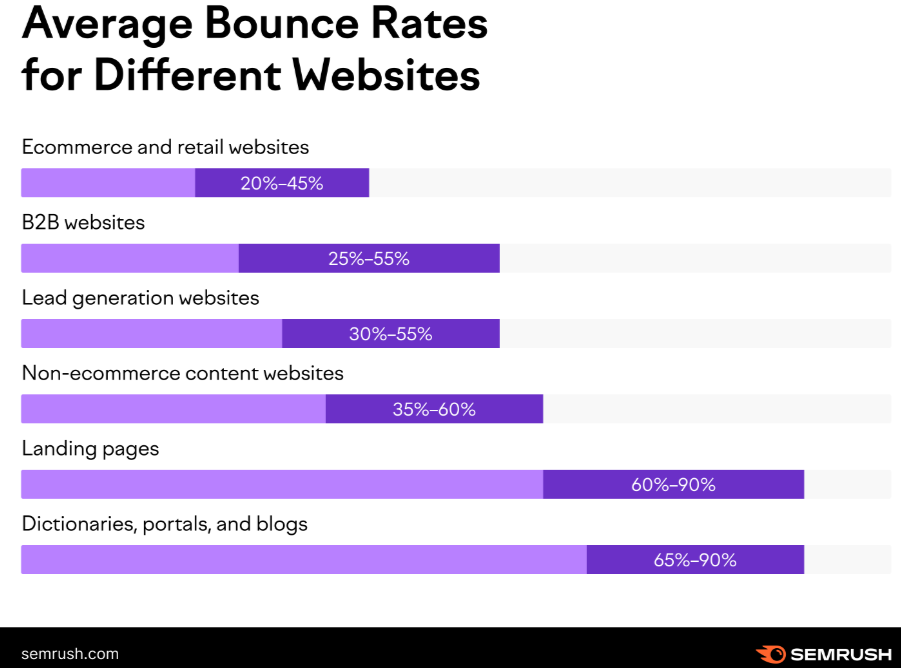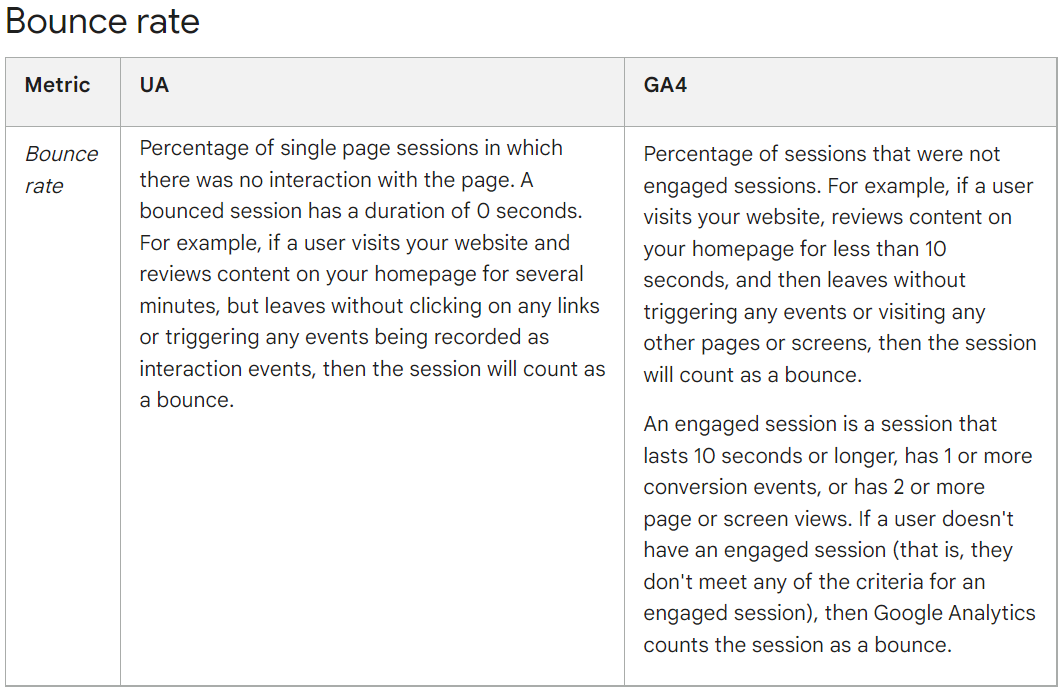For years, website owners have relied on bounce rate as a key metric for measuring the effectiveness of their website. However, in recent times, it’s become increasingly clear that bounce rate in some instances has proved to be a flawed and unreliable way of assessing user engagement.
The problem lies in the fact that bounce rate fails to take into account the quality of engagement that users have with a website, nor does it recognise the type of content featured on the website. In light of these shortcomings, Google decided to take a fresh look at things with Google Analytics 4 and instead focus on a new measure called ‘engagement rate’ as a far more effective metric for website owners to measure the success of their website.
Don’t get me wrong, it’s not the holy grail of measuring engagement - but in terms of assessing how users interact with the content on the website, engagement rate provides a more nuanced and accurate picture of the user experience, enabling website owners to make data-driven decisions to improve their website.
But in the interest of keeping this article from becoming a total bounce rate bitchfest, it’s worth taking a quick look at some of bounce rate’s good points.
#TeamBouncerate
While the title of this article will leave you in little doubt which side of the fence I’m on, there’s no doubt bounce rate has had its uses. Indeed, many marketing managers look at it as a key measure, and when Google announced bounce rate would not feature on GA4, a mini uproar ensued. So what has made it such a valuable metric for analysis? Let’s take a look.
- Identifying potential issues: A high bounce rate could indicate that there are problems with a website, such as poor page design, slow loading times or irrelevant content.
- Measuring the effectiveness of marketing campaigns: By tracking the bounce rate of specific landing pages or marketing campaigns, businesses can determine how successful these efforts are at attracting and engaging their target audience. If a campaign has a high bounce rate, it may not be resonating with the intended audience and require re-evaluation.
- Improving website content: By analysing the pages with the highest bounce rates, businesses may be able to determine which pages are not providing value to users.
- Understanding user behaviour: Bounce rate can provide insights into how users interact with a website. For example, a high bounce rate on a particular page may suggest that users are not finding what they expected, or are not being guided to relevant content.
All of which is great, but there are a lot of 'may not be’ and ‘might be able to’ caveats here, making it all uncomfortably subjective for a one-size-fits-all metric.
Here’s why.
Not all bounce rates are created equal
It's important not to make assumptions based solely on your website's bounce rate. While a high bounce rate could be an indicator that something needs fixing, there are cases where a high bounce rate is acceptable or even, dare I say it, desirable.
For example, a user might be searching for a contact number on your website which, once they’ve located it, means they have found the info they need and subsequently close the page down. If all customers did this, the bounce rate would be through the roof - but may have resulted in playing a key role in leads being converted over the phone rather than online.
Similarly, if your website primarily focuses on informational content - as an example let’s say a site featuring cake recipes, then your audience could find all they wanted to know right there on the page without having to click through to other parts of the website. Bounce rate high, but user satisfaction also high.
What is considered a ‘good’ bounce rate
Once again, context is required to answer a question like this. For an ecommerce website, the average bounce rate according to Semrush is 20% to 45%, whereas for blogs, dictionaries, etc., it’s significantly higher at 65%-90%.

Ecommerce and retail sites will of course want to keep bounce rates as low as possible for obvious reasons, but for informational sites the average rates are much higher. Does this mean these sites are deemed not to be as valuable or as relevant? Of course not. This is one of the reasons why bounce rate is not, and never has been, a ranking factor - it’s impossible to measure a site’s success based on engagement activity - there are just too many caveats.
Will GA4 spell the end for bounce rate?
In contrast to Universal Analytics, Google Analytics 4 places a greater emphasis on tracking events and actions rather than focussing on metrics that measure inactivity. This is why the platform has replaced the traditional bounce rate metric with the 'engagement rate' metric. The good news (or bad news, depending on your perspective) is that bounce rate hasn’t disappeared completely from GA4 (although it did in the first release), so if you prefer to keep your reporting old school then there is the option to set it up manually.

Bounce rate may be back, but it’s not a like for like in UA. It’s simply used to describe anything not classed as an engaged session (or simply 1 - engagement rate%!). The changes are highlighted in Google's table below:

Probably the key difference here is the 10 second rule. Previously, you could have found a really insightful, lengthy article featuring a topic of interest, spent 5 minutes reading it word for word, come away from the page feeling satisfied, yet that session would still be classed as a bounce. With the introduction of GA4’s engagement rate, any session lasting 10 seconds or longer, is now considered an ‘engaged session’. This is going to take a while for marketers to truly get to grips with I think and will also require a fair amount of knowledge sharing internally as even if you decide to carry on with bounce rate as a measure (hmmm), it’s really not a like for like comparison at all. Continuing to report on this year after year is most likely going to cause more issues than it solves!
What is an engaged session?
An 'engaged session' is one that ticks one or more of the following boxes:
- Two or more pages viewed
- Lasts 10 seconds or longer
- Contains one or more conversion events
Engagement rate is calculated as such: engaged sessions / total sessions.
If the session does not meet any of the requirements above it is not considered engaged and is therefore classed as a bounce. The table below breaks this down a little further:

In my view, engagement rate is a far more effective measure than the traditional bounce rate metric. The new 10 second threshold accounts for inconsistencies and ensures that engagement rate reflects users' level of interaction with the site.
Also, if you consider 10 seconds too short to be classed as a reasonable or credible engaged session, it’s possible to extend the default engaged session duration to 60 seconds. Great if you’re striving to determine a deeper level of engagement - just be mindful this will also lead to a lower engagement rate in your reporting.
Bounce rate wasn’t a ranking factor - what about engagement rate?
Google themselves have confirmed engagement rate is not a ranking factor. While a high engagement rate can of course be an indicator of quality and relevance (which Google loves), search engines recognise that engagement rates, similar to bounce rates, can be influenced by a number of factors, such as the timing of the post, the audience demographics and the fact the 10 second threshold can be extended, so we’re no longer conforming to one universal standard.
Final thoughts
I’ve been a big critic of GA4 and whilst it does have a lot of failings, the shift away from bounce rate is a good shout by Google in my opinion. Yes, for those seeking fundamental data, it can be beneficial. Nonetheless, there are simply too many discrepancies and variances for it to provide a truly insightful deepdive into user behaviour and website performance. That’s not to say engagement rate is the perfect solution - after all, just because a user stays on a page for 11 seconds instead of 9, is that really a great example of engagement?
We’re all still finding our feet with GA4, so it’ll be interesting to see over time whether we’ll really mourn the loss of bounce rate as we know it, or if indeed engagement rate proves to be a game-changer. I’m not inclined to go quite that far, but I’ll wager it's a step in the right direction.




